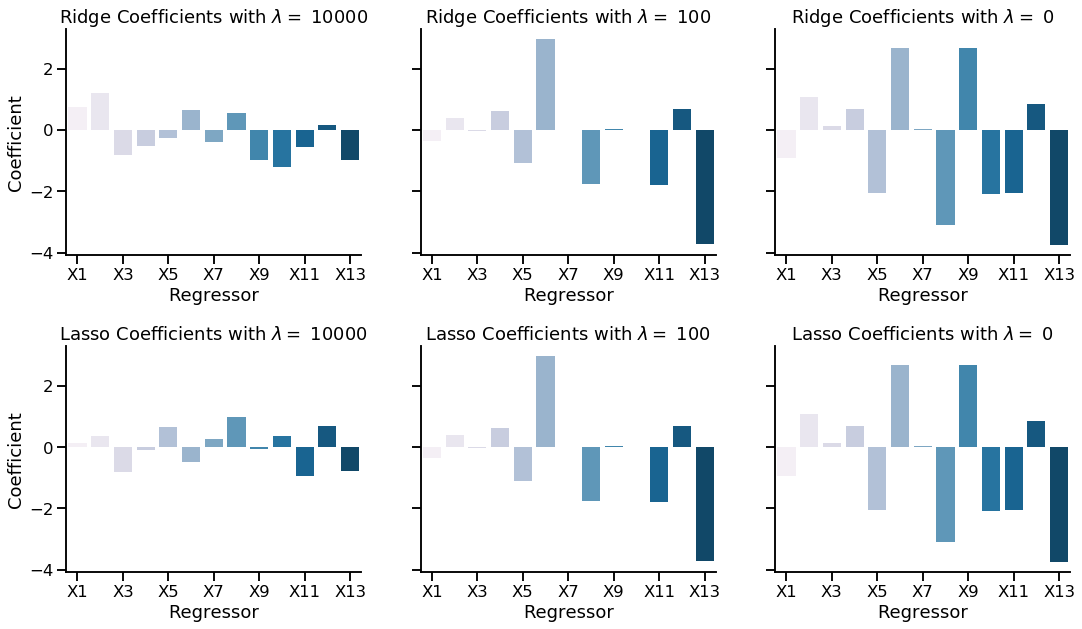Regularized Regression¶
import numpy as np
import matplotlib.pyplot as plt
import seaborn as sns
from sklearn import datasets
boston = datasets.load_boston()
X = boston['data']
y = boston['target']
Before building the RegularizedRegression class, let’s define a few helper functions. The first function standardizes the data by removing the mean and dividing by the standard deviation. This is the equivalent of the StandardScaler from scikit-learn.
The sign function simply returns the sign of each element in an array. This is useful for calculating the gradient in Lasso regression. The first_element_zero option makes the function return a 0 (rather than a -1 or 1) for the first element. As discussed in the concept section, this prevents Lasso regression from penalizing the magnitude of the intercept.
def standard_scaler(X):
means = X.mean(0)
stds = X.std(0)
return (X - means)/stds
def sign(x, first_element_zero = False):
signs = (-1)**(x < 0)
if first_element_zero:
signs[0] = 0
return signs
The RegularizedRegression class below contains methods for fitting Ridge and Lasso regression. The first method, record_info, handles standardization, adds an intercept to the predictors, and records the necessary values. The second, fit_ridge, fits Ridge regression using
The third method, fit_lasso, estimates the regression parameters using gradient descent. The gradient is the derivative of the Lasso loss function:
The gradient descent used here simply adjusts the parameters a fixed number of times (determined by n_iters). There many more efficient ways to implement gradient descent, though we use a simple implementation here to keep focus on Lasso regression.
class RegularizedRegression:
def _record_info(self, X, y, lam, intercept, standardize):
# standardize
if standardize == True:
X = standard_scaler(X)
# add intercept
if intercept == False:
ones = np.ones(len(X)).reshape(len(X), 1) # column of ones
X = np.concatenate((ones, X), axis = 1) # concatenate
# record values
self.X = np.array(X)
self.y = np.array(y)
self.N, self.D = self.X.shape
self.lam = lam
def fit_ridge(self, X, y, lam = 0, intercept = False, standardize = True):
# record data and dimensions
self._record_info(X, y, lam, intercept, standardize)
# estimate parameters
XtX = np.dot(self.X.T, self.X)
I_prime = np.eye(self.D)
I_prime[0,0] = 0
XtX_plus_lam_inverse = np.linalg.inv(XtX + self.lam*I_prime)
Xty = np.dot(self.X.T, self.y)
self.beta_hats = np.dot(XtX_plus_lam_inverse, Xty)
# get fitted values
self.y_hat = np.dot(self.X, self.beta_hats)
def fit_lasso(self, X, y, lam = 0, n_iters = 2000,
lr = 0.0001, intercept = False, standardize = True):
# record data and dimensions
self._record_info(X, y, lam, intercept, standardize)
# estimate parameters
beta_hats = np.random.randn(self.D)
for i in range(n_iters):
dL_dbeta = -self.X.T @ (self.y - (self.X @ beta_hats)) + self.lam*sign(beta_hats, True)
beta_hats -= lr*dL_dbeta
self.beta_hats = beta_hats
# get fitted values
self.y_hat = np.dot(self.X, self.beta_hats)
The following cell runs Ridge and Lasso regression for the Boston housing dataset. For simplicity, we somewhat arbitrarily choose \(\lambda = 10\)—in practice, this value should be chosen through cross validation.
# set lambda
lam = 10
# fit ridge
ridge_model = RegularizedRegression()
ridge_model.fit_ridge(X, y, lam)
# fit lasso
lasso_model = RegularizedRegression()
lasso_model.fit_lasso(X, y, lam)
The below graphic shows the coefficient estimates using Ridge and Lasso regression with a changing value of \(\lambda\). Note that \(\lambda = 0\) is identical to ordinary linear regression. As expected, the magnitude of the coefficient estimates decreases as \(\lambda\) increases.
Xs = ['X'+str(i + 1) for i in range(X.shape[1])]
lams = [10**4, 10**2, 0]
fig, ax = plt.subplots(nrows = 2, ncols = len(lams), figsize = (6*len(lams), 10), sharey = True)
for i, lam in enumerate(lams):
ridge_model = RegularizedRegression()
ridge_model.fit_lasso(X, y, lam)
ridge_betas = ridge_model.beta_hats[1:]
sns.barplot(Xs, ridge_betas, ax = ax[0, i], palette = 'PuBu')
ax[0, i].set(xlabel = 'Regressor', title = fr'Ridge Coefficients with $\lambda = $ {lam}')
ax[0, i].set(xticks = np.arange(0, len(Xs), 2), xticklabels = Xs[::2])
lasso_model = RegularizedRegression()
lasso_model.fit_lasso(X, y, lam)
lasso_betas = lasso_model.beta_hats[1:]
sns.barplot(Xs, lasso_betas, ax = ax[1, i], palette = 'PuBu')
ax[1, i].set(xlabel = 'Regressor', title = fr'Lasso Coefficients with $\lambda = $ {lam}')
ax[1, i].set(xticks = np.arange(0, len(Xs), 2), xticklabels = Xs[::2])
ax[0,0].set(ylabel = 'Coefficient')
ax[1,0].set(ylabel = 'Coefficient')
plt.subplots_adjust(wspace = 0.2, hspace = 0.4)
sns.despine()
sns.set_context('talk');

